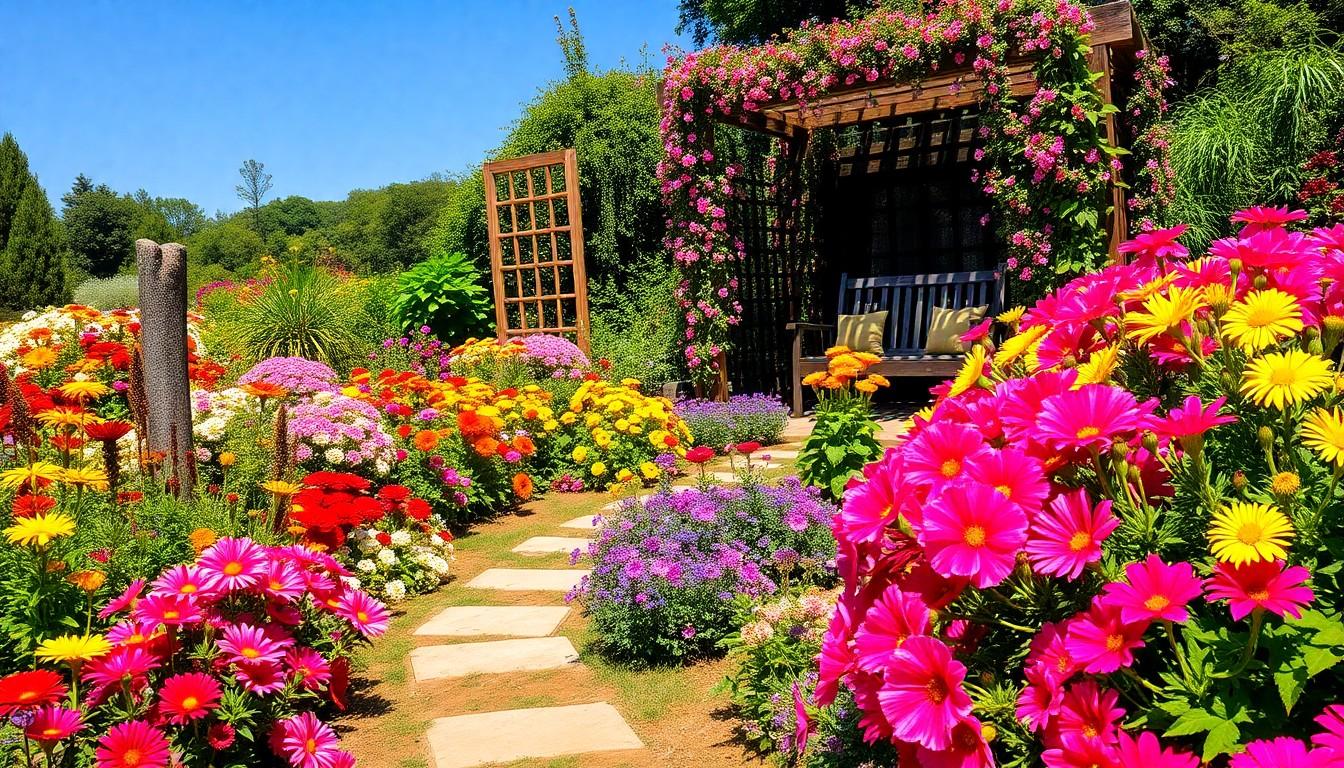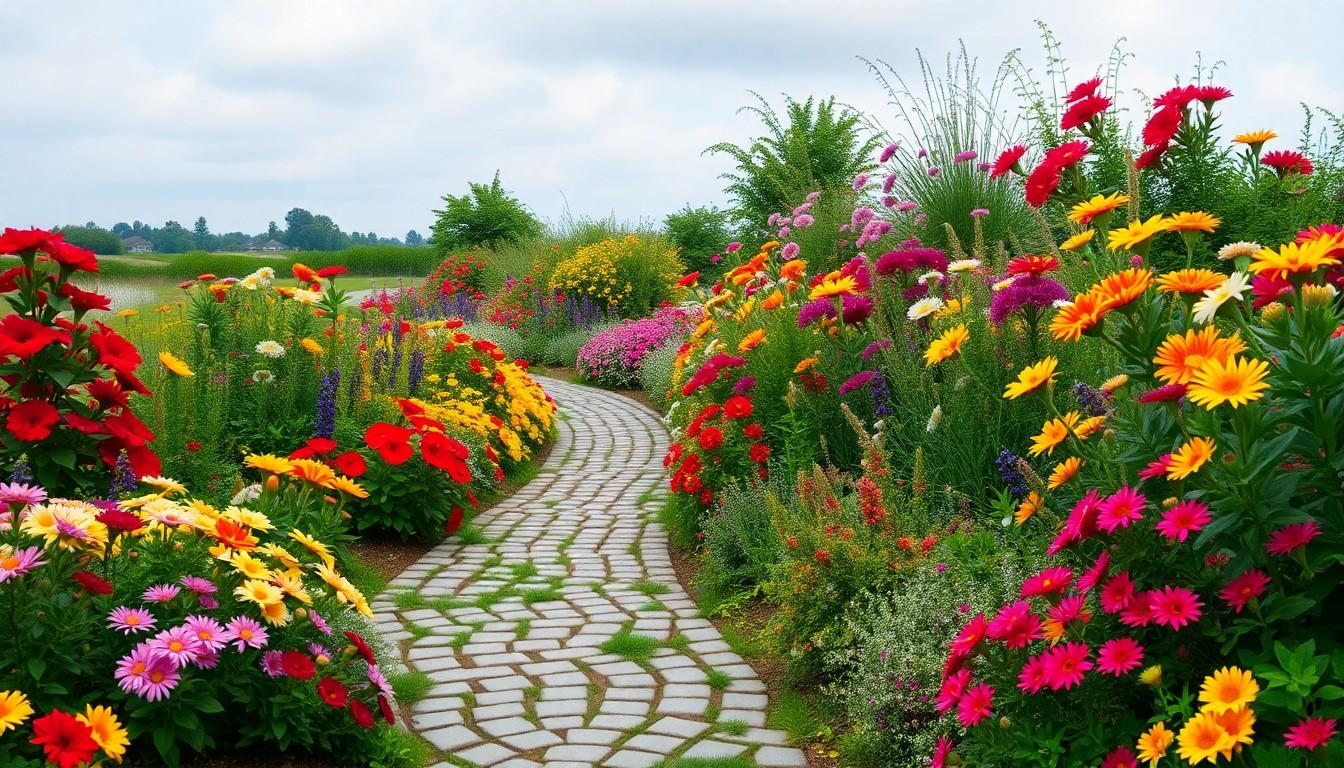Phone:
(701)814-6992
Physical address:
6296 Donnelly Plaza
Ratkeville, Bahamas.

Imagine stepping into a world where vibrant colors dance in the breeze and sweet fragrances float through the air. A well-designed flower garden isn’t just a patch of soil; it’s a living masterpiece that can transform any dull backyard into a floral wonderland. Whether you’re a seasoned gardener or someone who just wants to impress the neighbors, mastering flower garden design can bring joy and beauty to your outdoor space.
Flower garden design combines creativity with horticultural knowledge. It creates spaces that captivate the senses and enhances the overall appeal of a property. Elements include layout, color schemes, and plant selection, which play crucial roles in design effectiveness. A well-planned arrangement draws the eye and encourages exploration.
Attention to seasonal changes ensures year-round beauty. Choosing a mix of perennials and annuals allows for ongoing vibrancy. Native plants, for instance, offer ecological benefits while reducing maintenance. Selecting complementary colors creates a harmonious visual experience, while contrasts can add excitement and energy.
Incorporating pathways and seating areas improves accessibility and comfort. Features like trellises, arbors, and decorative containers provide vertical interest. Water elements, such as fountains or ponds, introduce tranquility and attract wildlife.
Understanding the garden’s microclimates helps in choosing the right plants for specific areas. Shaded spots, full sun, and well-drained spaces each require unique selections. Professional landscape designers often assess these conditions to maximize plant health and aesthetic value.
Considering the local climate and soil type also influences plant choices. For instance, drought-tolerant varieties suit arid conditions while moisture-loving plants thrive in wetter areas. Choosing the right mix of plants results in a flourishing garden that stands out throughout the seasons.
Creating a flower garden involves balancing artistry with practicality. Following essential design principles leads to a stunning landscape that showcases nature’s beauty. Building a flower garden isn’t just about flowers but also crafting an experience that invites joy and relaxation.

Flower garden design hinges on several key principles that ensure beauty and functionality. Understanding these aspects cultivates a vibrant outdoor space.
Color theory plays a pivotal role in flower selection. Different color combinations can evoke specific emotions and enhance visual appeal. For example, complementary colors like orange and blue create a striking contrast. Meanwhile, analogous colors such as yellow and orange produce a harmonious effect. Seasonal color shifts invite interest throughout the year, employing shades that bloom in different segments. Selecting flowers with varying heights adds depth to the color palette, creating layers that draw the eye. Strategizing color placement enhances pathways and focal points, further elevating the garden’s aesthetic.
Employing effective planting techniques and arrangements maximizes garden impact. Grouping plants in odd numbers creates a natural feel, while alternating heights maintains visual balance. Spacing considerations promote airflow and access, reducing the risk of disease. Emphasizing plant synergy encourages healthy growth and resource utilization. For instance, combining deep-rooted plants with shallow ones ensures effective soil use. Creating distinct zones with varied color and texture invites exploration, enhancing the overall experience. Rotating annuals and perennials maintains seasonal interest while optimizing health. These techniques collectively foster a flourishing and captivating garden.
Flower gardens come in various styles, each offering unique aesthetics and benefits. Understanding these types helps in creating a garden tailored to personal preferences and outdoor spaces.
Cottage flower gardens feature a relaxed, informal design. This style often includes colorful blooms paired with greenery that complements the surroundings. Plants like daisies, delphiniums, and hollyhocks thrive in these gardens, providing charm and inviting wildlife. Creating a sense of abundance, cottage gardens often utilize dense plantings with intertwining species. Paths may wind through the garden, encouraging exploration. Seasonal shifts introduce diverse colors, enriching the garden’s appeal year-round.
Formal flower gardens emphasize order and structure. They typically showcase geometric layouts, straight lines, and symmetrical designs. Common plants include roses, boxwoods, and peonies, chosen for their elegance. A balanced color scheme enhances visual impact, as each element plays a defined role. Pathways paved with stone or gravel guide visitors through these meticulously arranged spaces. Seasonal blooms are strategically placed, ensuring continuity and a polished look throughout the year. Such gardens create an atmosphere of sophistication and allure.
Selecting the right flowers significantly impacts the success of a flower garden. Understanding seasonal options and the differences between native and exotic plants enhances garden design.
Seasonal flowers offer vibrant beauty throughout the year. Spring brings tulips and daffodils, while summer showcases sunflowers and zinnias. Fall introduces chrysanthemums and asters, adding warmth to the garden. Winter gardens can feature hellebores and ornamental kale for visual interest. Planning for these seasonal options ensures a continually blooming landscape, creating a dynamic appeal that evolves with time.
Choosing between native and exotic plants affects both aesthetics and ecological health. Native plants adapt well to local conditions, requiring less water and maintenance. They often attract pollinators and wildlife, supporting local ecosystems. Exotic plants offer unique varieties and can create diverse looks, yet they may require more care and resources. Balancing these choices fosters a garden that is not only beautiful but also environmentally sustainable.
Creating a flower garden is an enriching journey that blends creativity with nature’s beauty. By thoughtfully selecting plants and designing layouts that reflect personal style, anyone can cultivate a stunning outdoor space. The balance of colors textures and seasonal blooms ensures a vibrant garden year-round.
Incorporating native plants not only enhances the garden’s appeal but also supports local ecosystems. Whether opting for a relaxed cottage garden or a structured formal design the possibilities are endless. Each choice contributes to a unique floral experience that invites joy and tranquility. Embracing these principles can transform any backyard into a captivating oasis.